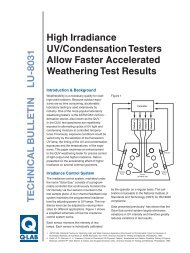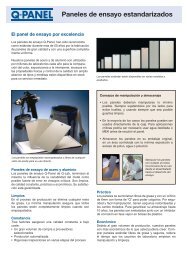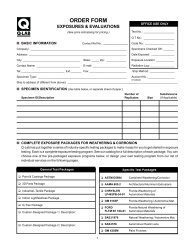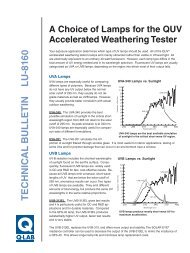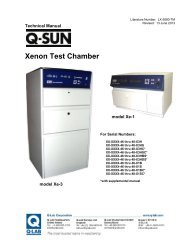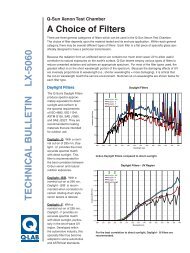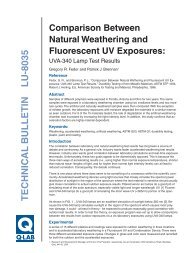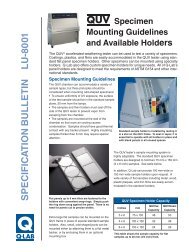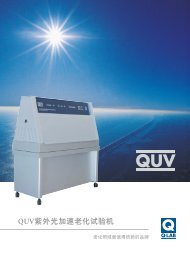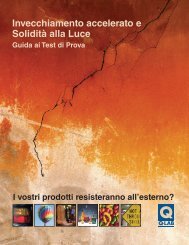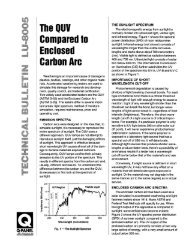Introduction to Cyclic Corrosion Testing - Q-Lab
Introduction to Cyclic Corrosion Testing - Q-Lab
Introduction to Cyclic Corrosion Testing - Q-Lab
Create successful ePaper yourself
Turn your PDF publications into a flip-book with our unique Google optimized e-Paper software.
Reporting<br />
In addition <strong>to</strong> all of the usual test conditions that<br />
need <strong>to</strong> be reported in conventional salt spray<br />
tests, CCT test reports should include:<br />
• Ramp time for all transitions in au<strong>to</strong>mated<br />
cabinet tests<br />
• Loading (i.e., number samples) of all<br />
au<strong>to</strong>mated cabinets<br />
• Daily range and mean temperature and<br />
relative humidity for the labora<strong>to</strong>ry room<br />
where “ambient” conditions are maintained<br />
in manual tests<br />
Advantages of Au<strong>to</strong>mated CCT<br />
<strong>Cyclic</strong> corrosion test methods were originally<br />
developed as labor intensive manual procedures.<br />
Au<strong>to</strong>mated, multi-functional chambers are now<br />
available and can perform CCT tests in a single<br />
chamber. Some of the advantages of au<strong>to</strong>mated<br />
systems are that they:<br />
• Eliminate manual moving of test specimens<br />
from one chamber <strong>to</strong> another<br />
• Eliminate laborious spraying of test<br />
specimens<br />
• Eliminate variability in results from excessive<br />
specimen handling<br />
• Allow more predictable transition times<br />
Common <strong>Cyclic</strong> <strong>Corrosion</strong><br />
Test Cycles<br />
The following cycles are in common use. This list<br />
is not comprehensive. The conditions shown below<br />
are merely a summary of the full instructions<br />
found in the various specifications, test methods<br />
and practices. Consult the actual documents for<br />
more complete instructions, warnings, etc.<br />
Other cycles may be more appropriate for your<br />
application. SAE J156315 is particularly useful as<br />
a source of guidance for cyclic testing.<br />
Prohesion Cycle<br />
The Prohesion test was developed in England<br />
for industrial maintenance coatings applications.<br />
Prohesion also has a reputation as a good test for<br />
filiform corrosion.<br />
The Prohesion electrolyte solution is much more<br />
dilute than traditional salt fog. In addition, the<br />
spray a<strong>to</strong>mizing air is not saturated with water.<br />
Exposure conditions include:<br />
Electrolyte Solution 0.05% sodium chloride<br />
& 0.35% ammonium<br />
sulfate<br />
Solution Acidity pH between 5.0 and 5.4<br />
The Prohesion exposure cycle is:<br />
1 hour Salt fog application at<br />
25°C (or ambient)<br />
1 hour Dry Off at 35°C (The<br />
dry-off is achieved by<br />
purging the chamber<br />
with fresh air, such that<br />
within 3/4-hour all visible<br />
droplets are dried off of<br />
the specimens.)<br />
Repeat<br />
15. J1563, Guidelines for <strong>Lab</strong>ora<strong>to</strong>ry <strong>Cyclic</strong> <strong>Corrosion</strong> Test Procedures for Painted Au<strong>to</strong>motive Parts.



